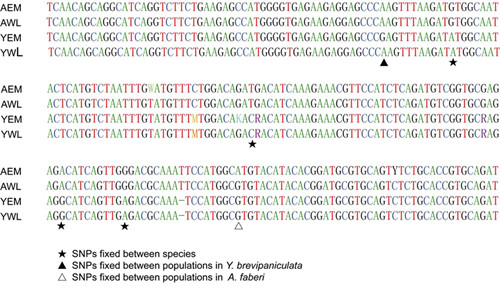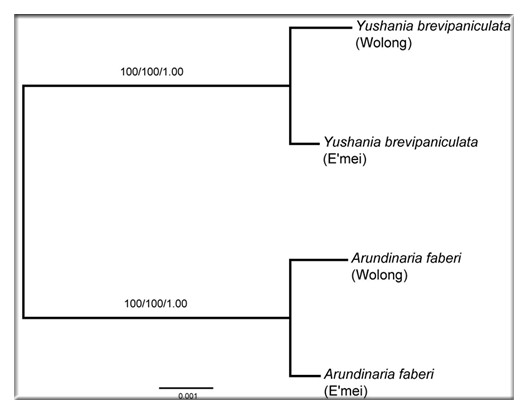The temperate bamboos are a morphologically diverse grass lineage with approximately 32 genera and 600 species distributed primarily in the North Temperate Zone or at high elevations in tropical regions of both the northern and southern hemispheres. There are approximately 430 species distributed in East Asia, of which 180 are endemic to Southwestern China. Previous phylogenetic studies strongly support the monophyly of temperate bamboos, but taxonomic delineation and phylogenetic relationships at lower levels within the clade lack resolution. Previous studies suggested that phylogenetic analyses based on large DNA fragments and whole chloroplast genomes could not resolve relationships within the lineages in the temperate woody bamboos.
Recently, Profs. GUO Zhenhua and Prof. LI Dezhu’group, from Kunming Institute of Botany, have used restriction site-associated DNA (RAD) sequencing to identify SNP markers from two different populations of A. faberi and Y. brevipaniculata, and to evaluate the performance of RAD sequencing for phylogeny reconstruction in temperate bamboos. Approximately 27 million paired-end sequencing reads were generated across four samples. Analyzed separately by population, they recovered 29,443 putatively orthologous RAD tags shared across the four sampled populations, containing 28,023 sequence variants, of which approximately 13,000 are segregating between species, and approximately 3,000 segregating between populations within each species. Phylogenetic analysis using the largest data set revealed robust support for the relationship between the two species (100% MPBS, 100% MLBS, 1.00 PP), as well as the monophyly of each species. For the data set in which twenty-nine loci were included, it produced the same results.
The current study represents an initial attempt at resolving complex evolutionary relationships in the temperate bamboos, using the largest collection of genome-wide SNPs yet used in bamboo phylogenetics. Extending this approach to a broader taxonomic sampling will help to elucidate the evolutionary history of temperate bamboos.
This work has been published online in Molecular Ecology Resources [Wang, X. Q., Zhao, L., Eaton, D. A. R., Li, D. Z. and Guo, Z. H. (2013), Identification of SNP markers for inferring phylogeny in temperate bamboos (Poaceae: Bambusoideae) using RAD sequencing. Molecular Ecology Resources, 13: 938–945. doi: 10.1111/1755-0998.12136].(http://onlinelibrary.wiley.com/doi/10.1111/1755-0998.12136/full)
This project was supported by the Knowledge Innovation Project of the Chinese Academy of Sciences (KSCX2-YW-N-067); the National Natural Science Foundation of China (30990244); NSFC-Yunnan province joint foundation (U1136603); Scientific Research Foundation for the Returned Overseas Chinese Scholars, State Education Ministry and the Young Academic and Technical Leader Raising Foundation of Yunnan Province (No.2008PY065, awarded to Zhen-Hua Guo); and the Yunnan Provincial Government through an innovation team program.

Fig. 1 Schematic representation of categories of SNPs fixed between species and populations.

Fig. 2 Phylogram of the 50% majority-rule consensus tree from Bayesian inference based on 29,443 loci. Support values are shown for nodes as maximum parsimony bootstrap/maximum likelihood bootstrap/Bayesian inference posterior probability. Branch lengths were calculated through Bayesian analysis, and scale bar denotes substitutions per site.




